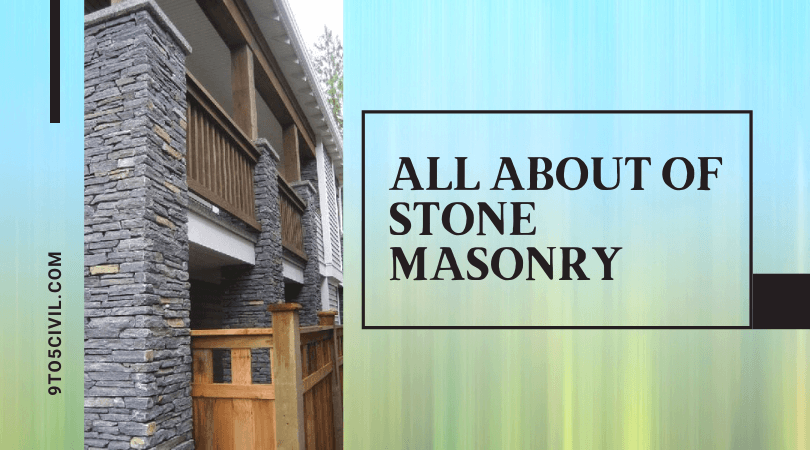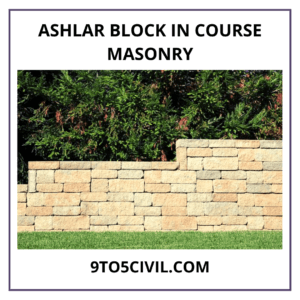
Stone Masonry
Stone masonry is a building material used since ancient times. Random rubble work is cheaper than brickwork in places where stones are readily available.
In masonry work, the structure of a building is constructed using building materials like stone, bricks and concrete blocks, etc. Mortar is used as a binding material for building blocks in masonry work.
This type of masonry can be used as an element in building construction. Different structures can be constructed from stone masonry in building construction using stones and mortar. stone masonry work is done in works like foundation, floor, retaining wall, arches, walls, columns, etc.
It is the oldest method of construction in human history. There are good examples of stone masonry in ancient times like various shelters, temples, monuments, artifacts, fortifications, roads, bridges, etc.
What Is Stone Masonry?
The construction of bonding stones by mortar is known as stone masonry. Where stones are naturally abundantly available. In such places, various structural elements can be made by cutting and dressing the stone in the right shape. Which provides economic material for the construction of walls, chimneys, arches, beams, etc.
Stone masonry can be used as stronger, more durable, and weather-resistant than brick masonry. It can be used in the construction of various structures such as piers, docks, dam lighthouses, and other marine structures.
Also Read : 23 Different Types of Doors | Functions of Doors
Types of Stone Masonry
- Rubble Masonry
- Ashlar Masonry
1. Rubble Masonry
This type of masonry uses dressing or undressing stone. Uniform thickness cannot be obtained in these masonry constructions.
The strength of a stone masonry depends on the quality of the mortar used in the masonary, the length of the stone, and the proper filling of the mortar in the joints between the stones, etc.
There are several types of rubble masonry
- Coursed Rubble Masonry
- Unsourced Rubble Masonry
- Dry Rubble Masonry
- Flint Rubble Masonry
- Polygonal Rubble Masonry
Also Read : What Is Lintel? | Size of Lintel Beam | Purpose of Lintel | Types of Lintel | Advantages of Lintel Beam
1.1. Coursed Rubble Masonry
This type of masonry work is done by dressing the stones on both faces with a hammer.
Therefore, in this type of masonry work, there are different stones of different sizes. This type of masonry work is commonly used in public buildings, abutments, and residential buildings.
1.2. Unsourced Rubble Masonry
Unsourced rubble masonry is the poorest and roughest form of masonry. The stones used in this type of masonry work are obtained directly from the quarry. In it, the mason is done dressing the weak corners and edges only with a hammer.
The stones are carefully laid in layers to avoid as thick joints as possible. In this type of masonry work thick joints, chips of stone, or spalls are avoided. This type of masonry work should use a uniform color, uniform bed, and large-sized rubble in the face stones.
This type of masonry work is initially laid before large stones. Then, the spaces between them are filled with spalls or sneaks.
This type of masonry work is divided into two types:
- Random uncoursed rubble masonry
- Square uncoursed rubble masonry
Also Read : What Is Retaining Walls? | Uses of Retaining Wall | Types of Retaining Wall | Advantages of Retaining Wall
1.2.1. Random Uncoursed Rubble Masonry
In this type of masonry work, the weak corners and edges of the stone are removed with the help of a hammer. Large stones are used in quinces and jambs to increase the strength of the masonry.
1.2.2. Square Uncoursed Rubble Masonry
This method is used in construction by dressing the stones in approximately square shapes. Special hammer-dressed finishes are given in facing stones. Large stones are used as queens in masonry work.
1.3. Dry Rubble Masonry
This type of rubble masonry is constructed without the use of mortar. In which the empty space between the stones is filled with small pieces of stone. It is used as pitching in various places for earthen dams and canal slopes.
This type of masonry work is cheaper than other types of masonry. Because it does not use mortar. But, this type of masonry work requires skilled manpower to pitch stones without mortar.
1.4. Flint Rubble Masonry
In areas where flint is abundant, flint is used in rubble masonry. This type of material has a hard surface. But have a brittle nature. Flint stones are usually 8 to 15 cm thick and 15 to 30 cm long.
1.5. Polygonal Rubble Masonry
In this type of masonry work, the rubble is arranged in roughly irregular polygons. They reduce the vertical joints between the two stones as little as possible in the work of the face. Stone chips are used to support the proper arrangement of this type of rubble masonry.
Also Read : What Is Retaining Walls? | Uses of Retaining Wall | Types of Retaining Wall | Advantages of Retaining Wall
2. Ashlar Masonry
Ashlar masonry is built using well-dressing stone. This type of masonry has beautiful joints. This type of masonry is arranged in different patterns.
In this type of masonry work, the thickness of the joints is kept to be about 3mm. The size of the stone blocks should correspond to the thickness of the walls.
Some types of ashlar masonry are provided as follows.
2.1. Ashlar Rough Masonry
In this type of masonry work, the face of the stones is made rough with the help of tools. It consists of a 25 mm wide strip of stone arranged around the perimeter of the rough-dressed face of each stone.
2.2. Ashlar Fine Masonry
In ashlar fine masonry, a stone of the same size and shape is used for each stone. The stones used in this type of masonry are almost rectangular in shape. Hence horizontal and vertical joints are formed with adjacent stones. ashlar fine masonry is more expensive than other types of masonry.
2.3. Ashlar Block in Course Masonry
This type of masonryis a combination of Ashler masonry and rubble masonry. The masonry stones are used to finish the face work or stones with hammer dress. Rubble masonry can be used to support the wall.
2.4. Ashlar Rock Quarry Faced
In this type of masonry, the edges of the stones are made straight and pointed in the arrangement of stones. In this type of stone masonry, the faces of the stones will look naturally shaped like a rock.
Specification of Stone Masonry
The specification of stone masonry is given below
- Stones should be cleaned and properly moistened before using in masonry work. So that the stone can be avoided by sucking water from the mortar in masonry work.
- Before masonry work, the dressing of stones should be done as per the prescribed requirement.
- Stones used for this type of masonry should be fireproof, hard, and durable.
- In stone masonry, the vertical alignment of the wall should be checked frequently with a plumb-bob.
- Continuous vertical joints of this type of masonry should be avoided.
- Small stone chips should not be used in this type of masonry.
- In stone masonry, the joints between the two stones should be thick enough and the joint should be completely filled with mortar.
- Curing this type of masonry is done for 2 to 3 weeks.
Also Read : What Is Interior Wall Finishes? | Type of wall finish
Advantages of Stone Masonry
- The use of this type of masonry in construction strengthens the structure of your building. Usually, the strength of this type of masonry depends on the strength of mortar.
- The structure of buildings is an important aspect to resist different weather throughout the year. This type of masonry has the ability to resist the effects of weather elements.
- This type of masonry is the most durable, strong, and weather-resistant construction.
- This type of masonry can be given an aesthetic look by using stones of different colors, sizes, and textures.
- The construction of stone masonry requires less maintenance and repair.
Disadvantage of Stone Masonry
- This type of masonry wall is thick and heavy, which reduces the total floor space.
- The stones used in this type of masonry are heavy. So it is very difficult to handle stones.
- The construction technique of this type of masonry requires skilled labor. The construction, repair or relocation of this type of masonry cannot be done easily.
- In this type of masonry, it is necessary to transport the stone to the designated places. Due to the weight of the stone, their transportation is expensive.
Like this post? Share it with your friends!
Suggested Read –
- What Is Brick Work Construction? | Types of Brick Work Construction | Classification of Brick Work | Application of Brickwork | Advantage & Disadvantage of Brick Work
- Type of Heavy Construction Equipment | Earth Moving Equipment | Material Handling Equipment
- The Standard Room Size & Location In House | Standard Room Size for Drawing or Living Room | Standard Size Of Bedroom | Standard Room Size for Kitchen | Standard Size Of Bathroom
- What Is CMU Wall? | Characteristics of CMU Block | CMU Block Dimensions | CMU Retaining Wall Construction | CMU Block Shapes | CMU Block Weight | Advantages & Disadvantages of CMU Walls |
- What Is Construction Cost Estimate? | Type of Construction Cost Estimate | Advantage of Construction Cost Estimate | Disadvantage of Construction Cost Estimate
Stone Masonry
The construction of stone masonry is more costly than brick masonry, but stones are more durable, hard, and strong as compared to brick. The weight of stones is heavy, they are not available in regular size.
Types of Stone Masonry
1. Rubble Masonry
A. Coursed rubble masonry, B. Uncoursed rubble masonry, C. Random rubble masonry, D. Dry rubble masonry.
2. Ashlar Masonry
A. Ashlar fine, B. Ashlar rough tooled, C. Ashlar quarry faced, D. Ashlar chamfered.
Stone Masonry Walls
The minimum thickness of walls in stone masonry can be 35 cm whereas, in brick masonry, walls of 10 cm thickness can be constructed.
Stone Masonry Construction
The use of stone masonry in construction strengthens the structure of your building. Usually, the strength of stone masonry depends on the strength of mortar.
 Skip to content
Skip to content 










